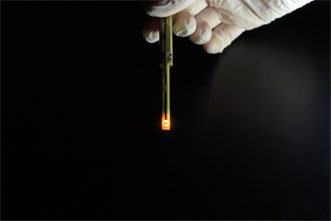
Nuclear Spins Boost Electric Current in OLEDs
A spintronic approach has been used to power plastic organic LEDs at room temperature and without strong magnetic fields.
“We have shown we can use room-temperature, plastic electronic devices that allow us to see the orientation of the tiniest magnets in nature — the spins in the smallest atomic nuclei,” said University of Utah professor Dr. Christoph Boehme. “This is a step that may lead to new ways to store information, produce better displays and make faster computers.”
He added that in spintronics, data are stored by the spins of either electrons or atomic nuclei. Nuclear spin orientations live longer, so they are better for storing data, according to the researchers.
In the study, Boehme’s team was able to read nuclear spins of two isotopes of hydrogen: a single proton or deuterium. The isotopes were embedded in an inexpensive plastic polymer (MEH-PPV), an OLED that glows orange when current flows through it.

An OLED is used to read the subatomic spins in the nuclei of hydrogen isotopes; those spins are used to control current to the OLED. Courtesy of Andy Brimhall/University of Utah.
They used magnetic resonance to reverse the nuclear spins, and then were able to detect how the reversed spins caused a change in the electrical current through the OLED.
In a subsequent experiment, the researchers flipped the spins back and forth at rates they controlled.
“It worked,” Boehme said. “This shows you can turn a nuclear spin when you want, and only then the current turns around. We can control a current by controlling nuclear spins.”
Boehme and colleagues conducted a similar study in 2010, in which they demonstrated that nuclear spins of phosphorus atoms could be controlled in a conventional silicon semiconductor, but at impractically low temperatures and only in very strong magnetic fields.
The work was funded by the U.S. Department of Energy. The research was published in Science (doi: 10.1126/science.1255624).
For more information, visit www.utah.edu.
Published: September 2014